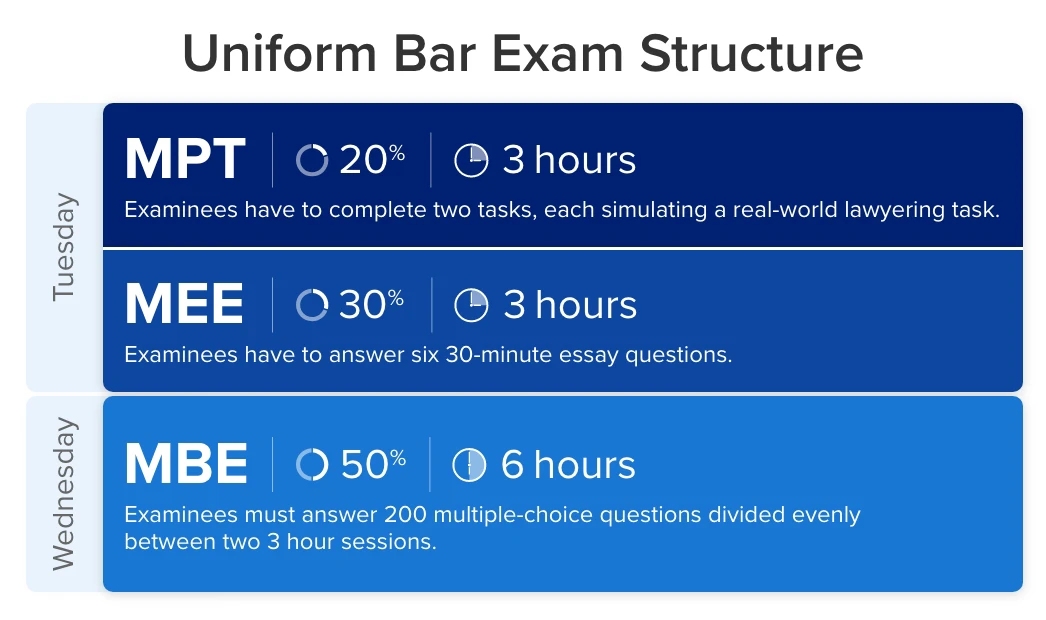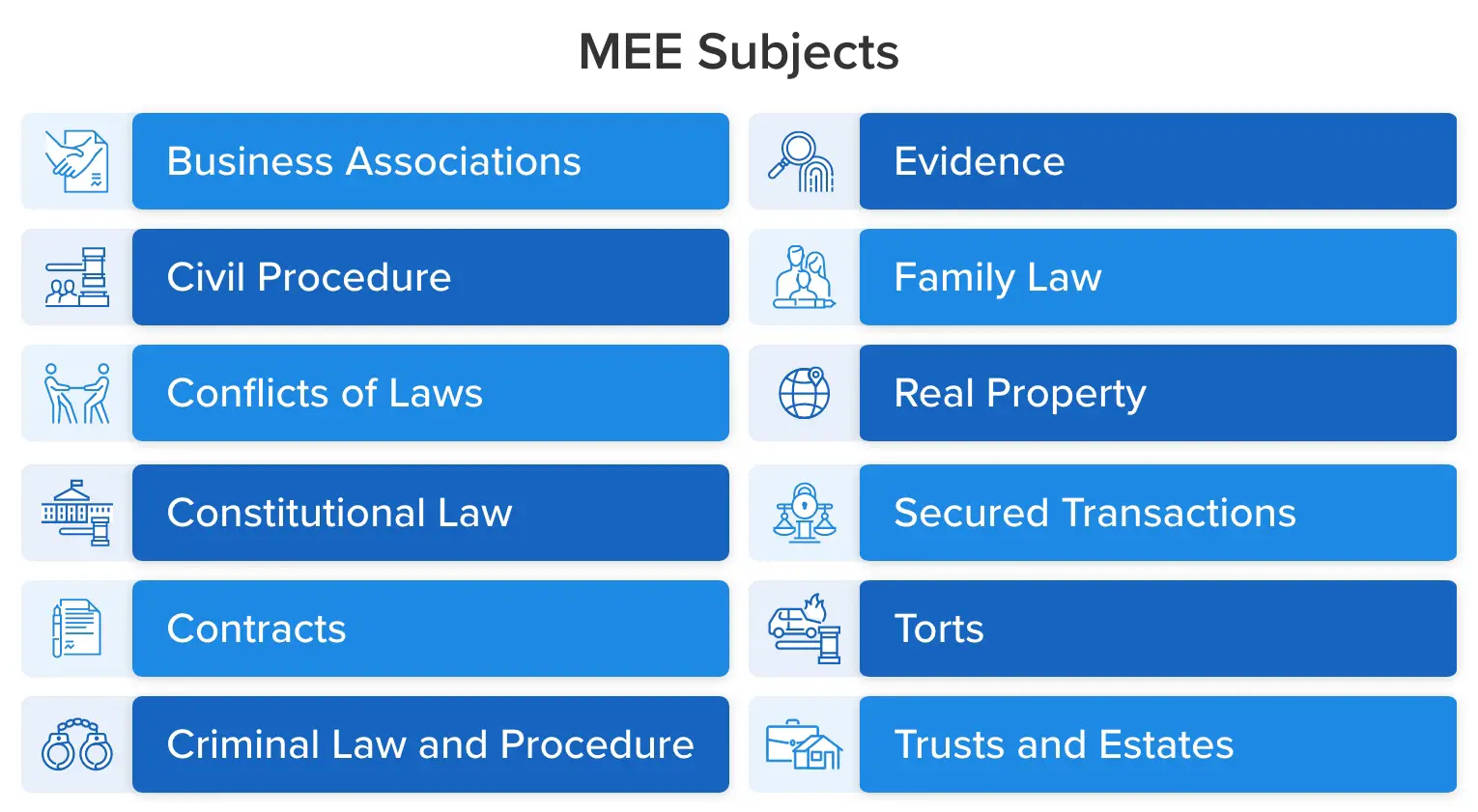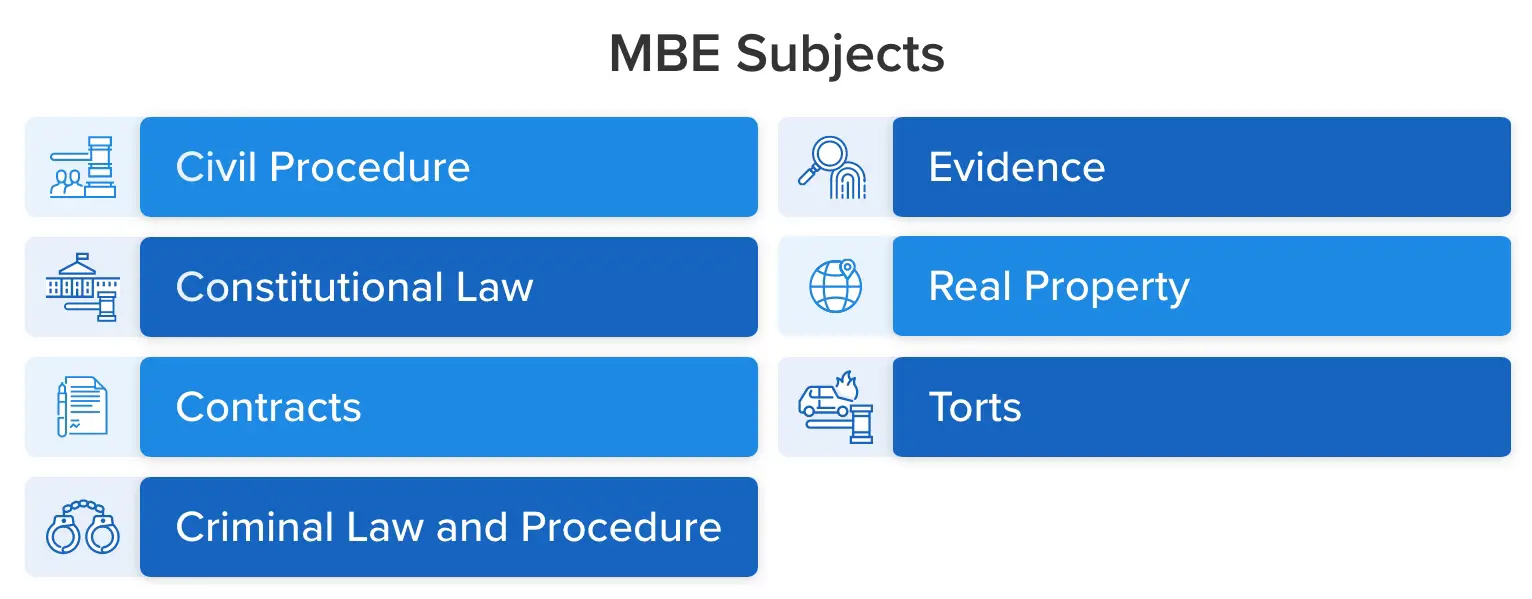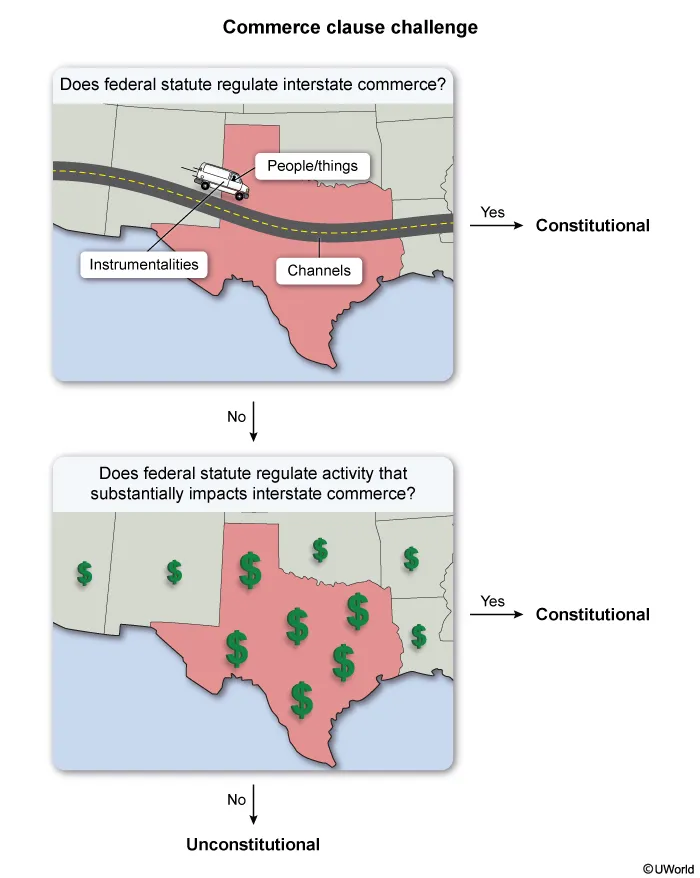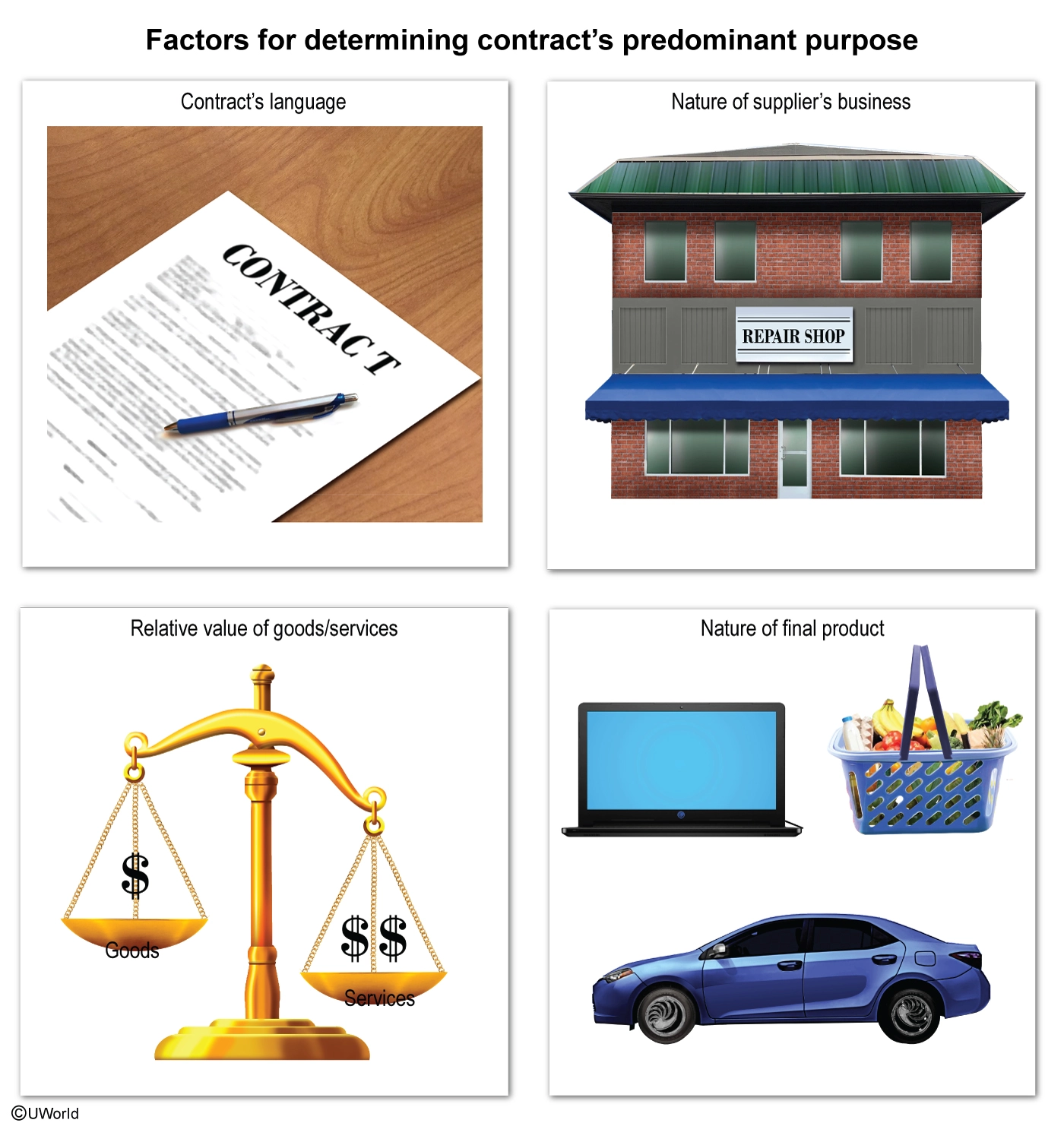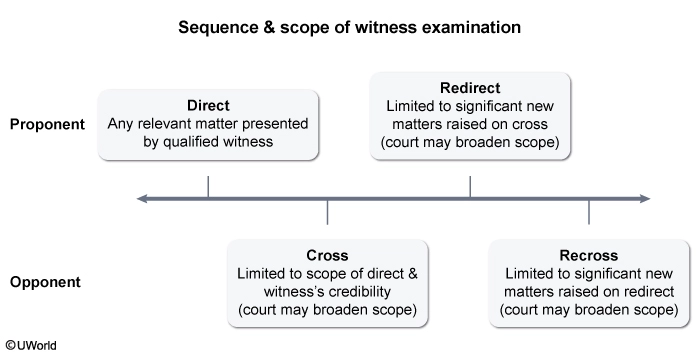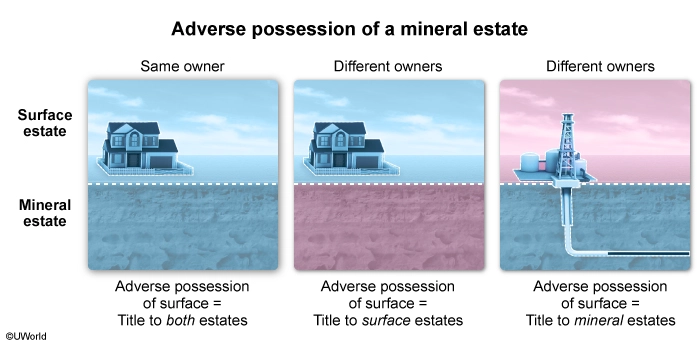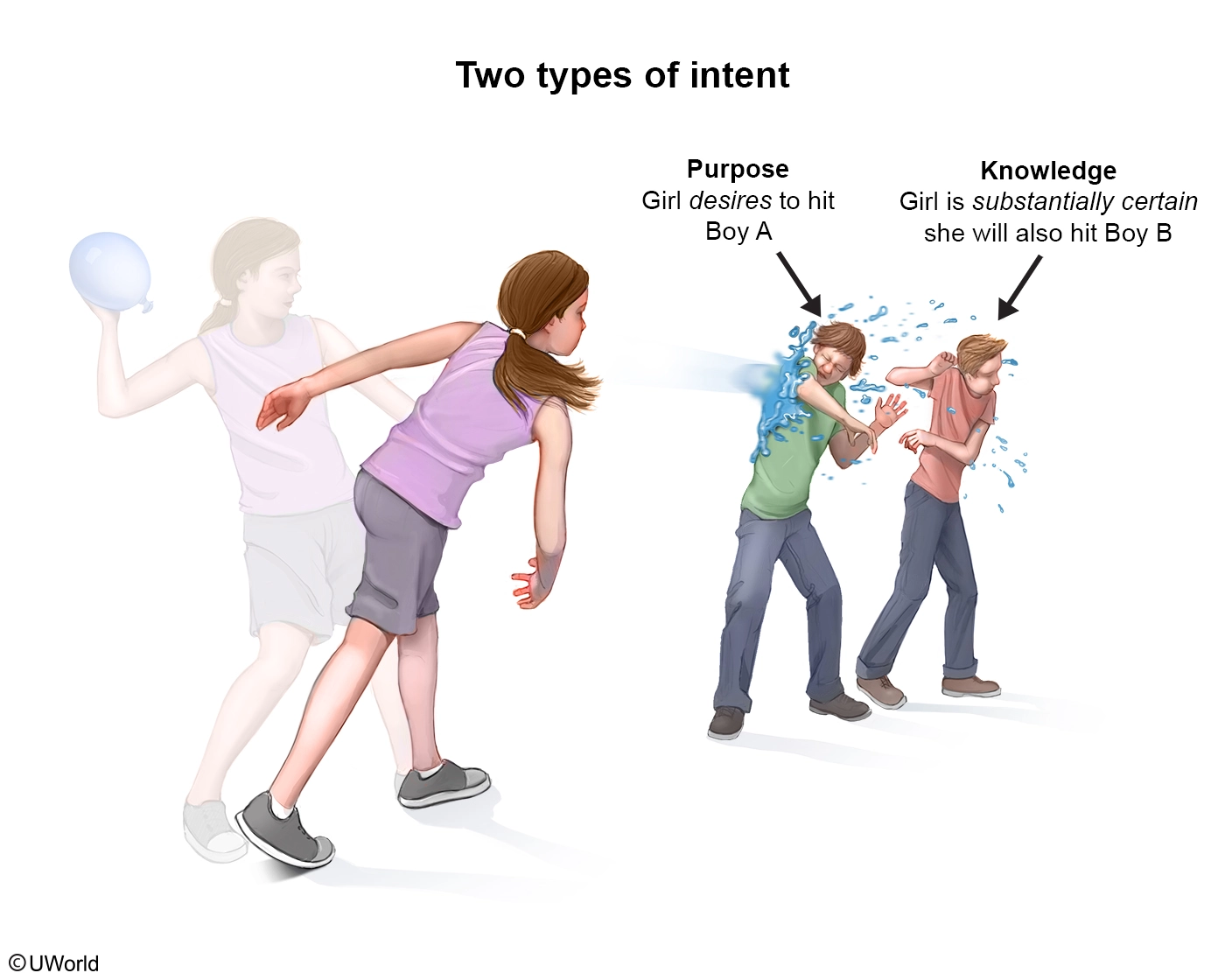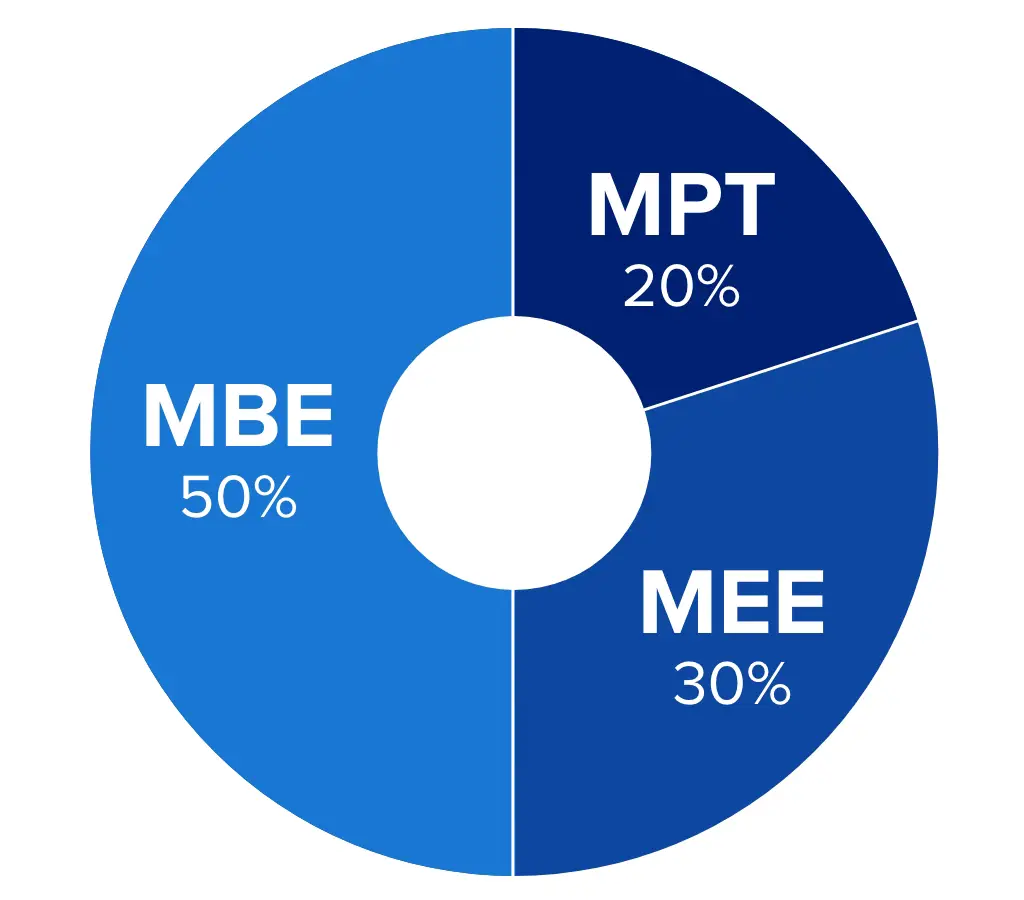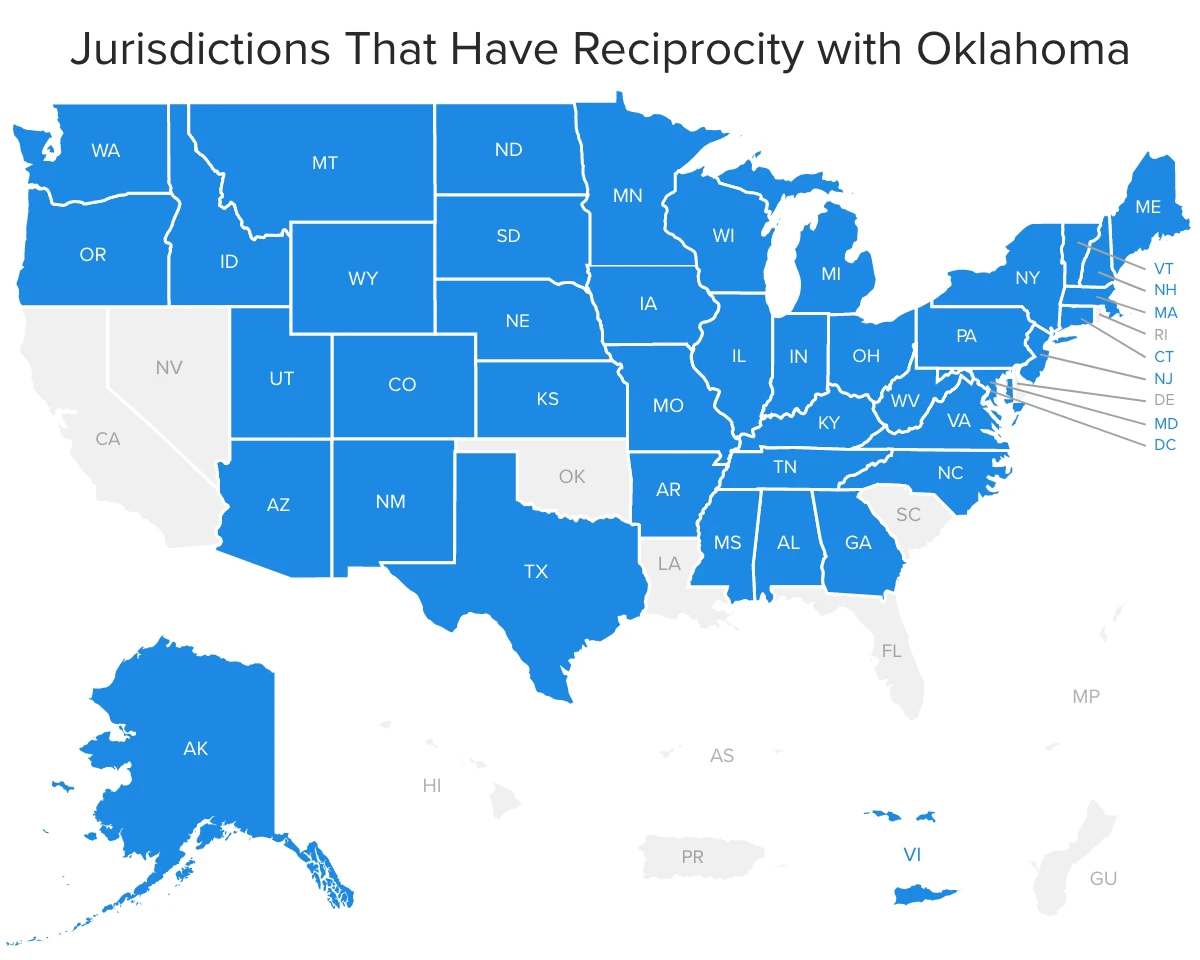In July 2021, the Oklahoma Bar Examination adopted the National Conference of Bar Examiners' (NCBE®) Uniform Bar Examination (UBE®) format, which consists of 3 sections: the Multistate Bar Examination (MBE®), the Multistate Performance Test (MPT®), and the Multistate Essay Examination (MEE®).
Applicants planning to practice law in multiple states can take advantage of the increased score portability among the 40 other jurisdictions that have adopted the UBE. Read on for further information regarding Oklahoma Bar Exam results, dates, deadlines, fees, applications, and more.
The Oklahoma Supreme Court will administer the NextGen bar exam beginning in July 2027.
Oklahoma Bar Exam Structure
The Oklahoma Bar Exam follows the structure of the UBE. The writing portion (MPT/MEE) is administered on the first day (Tuesday), and the MBE is administered on the second day (Wednesday) during the last week of February and July every year.
Oklahoma Bar Exam Dates, Requirements, and Scheduling
You can't pass an exam that you don't take. Check out what's required to sit for the OK Bar Exam below, along with important dates that you need to mark on your calendar.
Exam Dates
The Oklahoma Bar Exam is administered on the last Tuesday and Wednesday of February and July. First-time test takers must file before the final filing deadline, or they will not be allowed to sit for the exam. Filing past the timely or late filing date will cost you an extra $50 or $150, respectively. See the schedule below for details.
| Filing Periods | July 2025 Exam | February 2025 Exam | Fee |
|---|---|---|---|
| Timely Filing | TBA | NA/Lapsed | $650 |
| Late Filing | TBA | NA/Lapsed | +$50 |
Requirements
Eligibility to sit for the OK Bar Exam is based on the following requirements:
- Education — Have a Juris Doctorate (JD) degree or its equivalent from a law school accredited by the American Bar Association (ABA) or the Oklahoma Board of Bar Examiners (OBBE).
- Character and Fitness — Demonstrate good moral character and fitness to practice law. The Oklahoma Board of Bar Examiners will evaluate your background, including your employment history, financial responsibility, criminal record, and disciplinary actions taken against you by educational institutions or professional organizations.
- Application — Submit a completed application, including all required documentation and fees, to the Oklahoma Board of Bar Examiners by the specified deadline. This may include official transcripts, employment history, and character and fitness information.
Scheduling
To schedule your Oklahoma Bar Exam appointment, you must visit the OKBBE website and fill out the form that applies to your situation (i.e., attorney, registered law student, etc.). You'll most likely need a 2" x 2" photograph, an official certified transcript showing your final semester grades and your JD degree, your Multistate Professional Responsibility Examination (MPRE®) score report, your filing fee, and a notarized Affidavit, Authorization, and Release form.
All deadlines for submitting applications are based on the date the application arrives at the Oklahoma Board of Bar Examiners' office, not the date it is postmarked. In cases where a deadline falls on a non-working day, such as a weekend or legal holiday, applications will be accepted until the end of business hours on the following day.
Oklahoma Bar Exam Cost and Fees
It's important to register as a law student ($125) on or before October 15 of your 2nd year of law school. This is not an application to take the OK Bar Exam, but is necessary if you intend to take it. If you fail to register, you can file for Nunc Pro Tunc Registration ($500) after October 15 of your 2nd year of law school.
Do whatever you can to register on time. It will save you a substantial amount of money. The Oklahoma Bar Exam application for a registered law student is $650. For a student who registered late or Nunc Pro Tunc Registration, the fee is $1,150. See the fee schedule below for details.
| Application Fee | |
|---|---|
| Registered Law Student | $650 |
| Nunc Pro Tunc Registered* | $1,150 |
| For Attorneys | $1,250 |
| Repeaters | $650 |
| Other Application Fees | |
| Admission on Motion | $2,000 |
| UBE Score Transfer | $1,250 |
| Law Student Registration | $125 |
| Nunc Pro Tunc Registration | $500 |
| Misc. Fees | |
| Laptop Usage Fee | $50 |
Application fees are not eligible for a refund. Accepted credit cards for payment include Mastercard, Visa, and American Express.
Cost-Saving Options
Getting an undergraduate degree, a law degree, and applying for the Oklahoma Bar Exam is expensive. Fortunately, there are cost-saving options. The most simplest way to save money is to register in your second year of law school and apply for the exam by the timely filing deadline.
You can also look into the Oklahoma Bar Foundation Fellows Scholarship. This foundation awards $5,000 each to 3 law students every year. You must have been a documented continuous legal resident of the state of Oklahoma for the past 5 years, and demonstrate that you are in need of financial assistance and intend to practice law in Oklahoma.
If you don't meet the criteria for that scholarship, try browsing the AccessLex Institute Law School Scholarship Databank for options better suited to you. You can also check out the ABA, which offers 100+ opportunities and programs for young lawyers and law students. Even if you can't obtain a scholarship, there are some basic things you can do to save money while preparing for the bar exam:
- Join a study group and split the cost of bar exam preparation materials among group members.
- Research free or low-cost study online study materials like past bar exam questions and answers to supplement commercial study aids.
- Some bar exam prep companies offer discounts or promotions to students who register early or refer friends to their program.
Oklahoma Bar Exam Subjects and Topics
The OK Bar Exam measures a candidate's competency to practice law, their legal knowledge, and analytical abilities. It covers a wide range of topics, including criminal law and evidence, as well as contracts and constitutional law. To guarantee that candidates can successfully represent clients and carry out entry-level legal responsibilities, candidates will be evaluated based on their capacity to apply legal concepts, create legal documents, and effectively solve problems.
MEE Subjects
Some MEE subjects may be tested together, while others may not be tested at all. For example, Civil Procedure has been tested on almost every MEE for the past ten years, while Criminal Law has only appeared a few times.
Learn More
MPT Tasks
The MPT is designed to test an examinee's "lawyering skills" using only the materials provided. These tasks are conducted in a closed-universe, fictional jurisdiction called "Franklin." The laws of the real world do not apply, so your critical thinking skills and understanding of fundamental legal principles are key.
Learn More
MBE Subjects
The MBE is intended to assess a candidate's ability to apply fundamental legal principles and analyze complex fact patterns. Each question presents a hypothetical legal scenario, and test-takers must choose the best answer from four possible options.
UWorld MBE Sample Questions
Quality speaks for itself. Try some of our free MBE sample questions below.
A husband and wife were married in State A and lived there for 10 years before separating. One month later, the wife permanently moved to State B and immediately filed for divorce in a federal court in State B. The wife claims that she is entitled to $300,000 in alimony. The husband appeared in the action and has filed a motion to dismiss for lack of subject-matter jurisdiction.
Should the court grant the motion?
- No, because the court has diversity jurisdiction over the case.
- No, because the husband waived a subject-matter jurisdiction challenge by appearing in the case.
- Yes, because state courts have exclusive jurisdiction over this type of action.
- Yes, because the wife did not establish a domicile in State B.
Explanation:
| Federal diversity jurisdiction exceptions |
|
Federal courts cannot exercise diversity jurisdiction over cases involving:
|
A federal court must possess subject-matter jurisdiction to hear the merits of a case before it. Subject-matter jurisdiction can be established through either:
- federal-question jurisdiction – when a claim arises under the U.S. Constitution, a treaty, or federal law (not seen here) or
- diversity jurisdiction – when the amount in controversy exceeds $75,000 and the opposing parties are citizens of different states.
Here, diversity jurisdiction is established since the wife claims that she is entitled to $300,000 and the parties are citizens of different states (States A and B). However, federal courts cannot exercise diversity jurisdiction over cases involving probate matters or domestic relations. Instead, state courts have exclusive jurisdiction over these types of actions (Choice A).* Therefore, the husband's motion to dismiss should be granted.
(Choice B) A challenge to subject-matter jurisdiction is never waived. However, a challenge to personal jurisdiction is waived if the defendant has voluntarily appeared in the case, unless it was a special appearance for the express purpose of objecting to personal jurisdiction.
(Choice D) An individual is a citizen of the state where he/she is domiciled—ie, physically present with the intent to remain indefinitely. Since the wife permanently moved to State B, she has established her domicile there.
Educational objective:
Federal courts cannot exercise diversity
jurisdiction over cases involving probate matters or domestic relations. Instead, state courts
have exclusive jurisdiction over these types of cases.
Bluebook Citations :
- Ankenbrandt v. Richards, 504 U.S. 689, 703–04 (1992) (explaining the domestic-relations exception to diversity jurisdiction).
A congressional committee investigated the pharmaceutical industry and found that the high cost of prescription drugs purchased and sold in the United States negatively impacted the nation's economy and the health of its citizens. In response, Congress passed a statute that regulates "the retail prices of every purchase or sale of prescription drugs in the United States."
A group of pharmaceutical companies challenged the constitutionality of this statute in federal court.
What is the strongest argument in support of the constitutionality of this statute?
- Congress may enact statutes for the general welfare.
- Congress may regulate the prices of all domestic purchases and sales of goods.
- The Constitution grants Congress the power to regulate the interstate transportation of prescription drugs.
- The purchases and sales of prescription drugs in the United States substantially impact interstate commerce in the aggregate.
Explanation:
The commerce clause gives Congress broad power to regulate interstate and foreign commerce. This includes:
- the channels of interstate and foreign commerce (eg, roadways)
- the instrumentalities of interstate and foreign commerce (eg, vehicles)
- persons and things moving in interstate or foreign commerce (eg, goods and services) and
- in-state activities that, singly or in the aggregate, substantially impact interstate or foreign commerce.
Since Congress's commerce power is broad, federal statutes are constitutional if there is any rational basis for concluding that the regulated activity substantially affects interstate or foreign commerce. This can be shown through express congressional findings.
Here, the federal statute regulates the retail prices of prescription drugs in the United States. Congress has the authority to regulate such products' interstate transportation, but this statute also regulates in-state purchases and sales (Choice C). Since the congressional committee found that the high cost of prescription drugs negatively impacted the nation's economy, it is rational to conclude that their aggregated in-state purchases and sales substantially impact interstate commerce. Therefore, this is the strongest argument to support this statute.
(Choice A) The taxing and spending clause empowers Congress to tax and spend for the general welfare. But regulating prices is not equivalent to taxing or spending.
(Choice B) Congress cannot regulate the prices of every domestic purchase and sale of goods since it cannot regulate purely in-state sales that do not substantially affect interstate commerce.
Educational objective:
The commerce clause empowers Congress to regulate (1)
channels and instrumentalities of, (2) persons and things moving in, and (3) in-state activities
that—singly or in the aggregate—substantially affect interstate or foreign commerce.
Bluebook Citations :
- Gonzales v. Raich, 545 U.S. 1, 17 (2005) (explaining Congress's broad authority under the commerce clause).
The owner of a new office building contracted with a well-known landscaper to design and install landscaping around the building for $30,000. The agreement was memorialized in writing, was signed by both parties, and called for a budget of $5,000 for trees, shrubs, sod, and materials. The contract required the landscaper to complete the work within six months. Due to an unexpected increase in the price of trees and shrubs, the landscaper abandoned the project and never completed any of the work.
Three years after the landscaper's deadline, the building owner sued the landscaper for breach of contract. In the jurisdiction, the statute of limitations for breach of a services contract is two years after the breach, and the statute of limitations for breach of a sale-of-goods contract is four years.
Can the owner recover damages from the landscaper?
- No, because the contract is divisible with respect to the services and goods, and the landscaper's breach is therefore subject to the two-year statute of limitations.
- No, because the contract primarily calls for services, and the landscaper's breach is therefore subject to the two-year statute of limitations.
- Yes, because the landscaper's breach was a result of an increase in the price of goods, and his breach is therefore subject to the four-year statute of limitations.
- Yes, because the landscaper's breach was willful, and he is therefore estopped from denying that his breach is subject to the four-year statute of limitations.
Contracts for the sale of goods are governed by Article 2 of the Uniform Commercial Code (UCC), while contracts for services are governed by common law. However, some contracts involve the sale of goods and the rendering of services. To determine which law applies to a "mixed" or "hybrid" contract, courts ask whether its predominant purpose was the sale of goods or the rendering of services. The following factors are relevant to this determination:
- The contract's language
- The nature of the supplier's business (ie, whether it typically provides goods or services)
- The relative value of the goods and services
- The nature of the final product (ie, whether it can be described as a good or service)
Here, the building owner contracted to buy goods (eg, trees, shrubs, sod) and services (ie, designing and installing the landscaping). The owner likely hired the well-known landscaper due to his skill in performing landscaping services, and the $5,000 budget for goods was just one-sixth of the $30,000 contract price. Therefore, the contract primarily calls for services and is subject to the jurisdiction's two-year statute of limitations. And since the owner sued three years after the breach, the owner cannot recover damages from the landscaper.
(Choice A) The predominant-purpose test is unnecessary when a contract is divisible—ie, when the payment for goods can easily be separated from the payment for services. But here, the contract is likely indivisible since it combined the sale of the trees, shrubs, and sod with their installation.
(Choices C & D) The predominant-purpose test focuses on the parties' reason for entering the contract—not for breaching it. Therefore, it is irrelevant that the landscaper's breach was (1) a result of an increase in the price of goods or (2) willful.
Educational objective:
Sale-of-goods contracts are governed by the UCC,
while services contracts are governed by common law. When a contract calls for the sale of goods
AND the rendering of services, the contract's primary purpose determines whether the UCC or
common law applies.
Bluebook Citations :
- Bonebrake v. Cox, 499 F.2d 951, 960 (8th Cir. 1974) (applying the predominant-purpose test to determine which statute of limitations applies to a mixed contract for goods and services).
- Princess Cruises, Inc. v. Gen. Elec. Co., 143 F.3d 828, 833 (4th Cir. 1998) (listing factors that courts consider when applying the predominant-purpose test).
A man and a woman dated for several weeks. During that time, the man repeatedly asked the woman to have sex. Each time, the woman responded that she would not have sex with the man unless they were married. One evening, the man promised the woman that they would elope the following weekend if she would agree to have sex. The woman agreed and the couple had sex. The following weekend, the man told the woman that he had no intention of eloping and only made that promise to get the woman's consent. The woman reported the man to the police, who later arrested and charged the man with rape.
Is the man guilty of rape?
- No, because fraud in factum did not negate the woman's consent.
- No, because fraud in the inducement did not negate the woman's consent.
- Yes, because the woman's consent was obtained by fraud in factum.
- Yes, because the woman's consent was obtained by fraud in the inducement.
Explanation:
| Consent to sexual intercourse obtained by fraud | ||
| Type of fraud | Definition | Effect |
| In factum |
|
Negates victim's consent |
| In inducement |
|
Does not negate victim's consent |
In most modern jurisdictions, rape is defined as sexual intercourse with another without that person's consent.* This means that rape did not occur if the victim consented to sexual intercourse. However, a victim's consent may be ineffective if it was obtained by fraud. There are two types of fraud:
- Fraud in factum – when consent is obtained by fraud regarding the nature of the act itself, leaving the victim unaware that he/she consented to sexual intercourse and negating the victim's consent
- Fraud in the inducement – when consent is obtained by fraud regarding what the victim knows is an act of sexual intercourse, which does not negate the victim's consent
As a result, consent obtained by fraud in factum is not a valid defense to rape, but consent obtained by fraud in the inducement is a valid defense.
Here, the man falsely promised the woman that they would elope if she agreed to have sex with him. Since the woman knew that the act to which she consented was sexual intercourse, her consent was obtained by fraud in the inducement (Choices A & C). This type of fraud did not negate the woman's consent, so the man is not guilty of rape (Choice D).
Educational objective:
Fraud in factum occurs when the fraud pertains to the nature of the act itself and negates a rape victim's consent. In contrast, fraud in the inducement occurs when fraud is used to gain consent to what the victim knows is an act of sexual intercourse and does not negate the victim's consent.
A plaintiff sued a defendant for negligence to recover damages that the plaintiff suffered as a result of a crash between the two parties. At trial, the plaintiff's attorney called the plaintiff's wife to testify as to what she witnessed on the day of the crash. On cross-examination of the wife, the defendant's lawyer elicited several responses that tended to show that the plaintiff's actions constituted contributory negligence. The plaintiff's attorney seeks to ask the wife several questions on redirect examination, but the defendant's attorney objected.
What is the strongest argument that the court must allow redirect examination of the wife?
- The plaintiff's attorney failed to provide all significant information on direct examination.
- The plaintiff's attorney seeks to reiterate the necessary elements of the claim.
- The plaintiff's attorney seeks to reply to all matters raised on cross-examination.
- The plaintiff's attorney seeks to reply to significant new matters raised on cross-examination.
Explanation:
Federal Rule of Evidence 611 gives trial courts the authority to exercise reasonable control over the mode and order of examining witnesses at trial. This includes the discretion to determine whether—and to what extent—redirect examination of witnesses should be permitted. But when a party raises a significant new matter while cross-examining a witness, the court must allow the opposing party to address that matter through redirect examination.
Therefore, the strongest argument for allowing redirect examination of the plaintiff's wife is that the plaintiff's attorney seeks to reply to significant new matters that were raised on cross-examination.
(Choice A) A party is expected to elicit all significant information during direct examination of a witness. Therefore, a court need not permit redirect examination to allow the party to provide information inadvertently omitted on direct examination.
(Choices B & C) Redirect examination is generally limited to significant new matters raised on cross-examination. Therefore, a party is not entitled to redirect examination to (1) reiterate information like the necessary elements of the claim or (2) reply to all matters addressed in cross-examination.
Educational objective:
When a party raises a significant new matter on cross-examination of a witness, the court must allow redirect examination by the opposing party to address that matter.
Bluebook Citations :
- Fed. R. Evid. 611 (explaining the mode and order of examining witnesses).
Twenty years ago, a man who owned a 20-acre ranch agreed to sell all of his mineral rights to his neighbor. The man executed a warranty deed conveying the mineral estate to the neighbor, who failed to record the deed.
The following year, a woman moved her mobile home onto an undeveloped five-acre portion of the man's ranch. After the woman had lived on the property for 10 years, a local drilling company began operations on a nearby tract to drill a natural gas well. Believing that the woman owned the property, the drilling company approached the woman about leasing the mineral rights on her property and requested that the woman sign a lease of her mineral rights. The woman signed the lease as requested, and it was promptly and properly recorded. The drilling operations were successful, and the drilling company prepared to distribute profits from royalties. However, a dispute arose between the neighbor and the woman, as both parties claim ownership of the minerals.
The period of time to acquire title by adverse possession in the jurisdiction is 10 years.
In an action to determine title, is the court likely to award title to the mineral estate to the woman?
- No, because the woman actually possessed only the surface estate that had previously been severed from the mineral estate.
- No, because the woman did not actually possess the mineral estate until she signed the lease of the mineral rights.
- Yes, because the neighbor failed to record the warranty deed conveying the mineral estate.
- Yes, because the woman adversely possessed both the surface estate and the mineral estate for the statutory period.
Explanation:
An adverse possessor can acquire title to land owned by another if his/her possession of the land is:
- Open and notorious – apparent or visible to a reasonable owner
- Continuous – uninterrupted for the statutory period
- Exclusive – not shared with the owner
- Actual – physical presence on the land and
- Nonpermissive – hostile and adverse to the owner.
If the surface and mineral estates are owned by the same party, then the adverse possessor will acquire title to both estates—even if only one estate is actually possessed. But if the mineral estate has been severed from the surface estate (ie, the surface and mineral estates are owned by different parties), then the adverse possessor will only acquire title to the estate that is actually possessed. The mineral estate is actually possessed when the adverse possessor mines or drills wells on the land.
Here, the neighbor purchased the mineral estate from the man, thereby severing the mineral estate from the surface estate. And since the woman merely lived on the property for the 10-year statutory period—she did not attempt to mine or drill a well on the mineral estate—she actually possessed only the surface estate during that time (Choice D). This means that the woman did not adversely possess the mineral estate, and the court is not likely to award her title to that estate.
(Choice B) Adverse possession of a mineral estate requires the commencement of drilling or mining operations. Merely signing a lease of the mineral rights is not enough.
(Choice C) A deed need not be recorded to be valid, so the neighbor's failure to record has no impact on whether the woman adversely possessed the mineral estate.
Educational objective:
If a mineral estate has previously been severed from the surface estate (ie, surface and minerals owned by different persons), then an adverse possessor can only acquire title to the mineral estate by actually possessing the minerals (eg, by mining or drilling wells).
A teenager was riding a bicycle when she saw a classmate walking toward her. The teenager rode quickly toward the classmate, knowing that he would think she would run into him on her current trajectory. The teenager was not purposefully trying to harm or touch him. The classmate saw the teenager riding toward him and yelled at her to stop. The teenager swerved at the last moment and avoided hitting him. The classmate had a panic attack because he thought that the teenager would hit him.
Is the classmate likely to succeed if he sues the teenager for assault?
- No, because the teenager did not make contact with the classmate.
- No, because the teenager did not purposefully try to harm or touch the classmate.
- Yes, because the teenager acted with the requisite intent.
- Yes, because the teenager's conduct was extreme and outrageous.
Explanation:
Assault occurs when (1) a defendant intends to cause the plaintiff to anticipate an imminent, and harmful or offensive, contact with the plaintiff's person and (2) the defendant's affirmative conduct causes the plaintiff to anticipate such contact. The intent requirement is met when the defendant acts with either:
- purpose – the desire to cause anticipation of an imminent harmful or offensive contact or
- knowledge – the substantial certainty that the plaintiff will suffer such anticipation.
Here, the teenager rode her bicycle directly at her classmate, causing him to think that she would hit him (anticipation of imminent contact). And since the teenager knew with substantial certainty that the classmate would think she would run into him, she acted with the requisite intent. As a result, the classmate is likely to succeed in a suit against the teenager for assault.
(Choice A) Assault merely requires that the plaintiff be placed in anticipation of imminent contact. Actual bodily contact is not required. Therefore, the fact that the teenager did not make contact with the classmate is irrelevant.
(Choice B) The intent to make contact with the plaintiff is a requirement for battery, but assault merely requires the intent to cause the plaintiff to anticipate imminent contact. Therefore, the fact that the teenager did not purposefully try to harm or touch the classmate does not absolve her of liability for assault.
(Choice D) Extreme and outrageous conduct (i.e., conduct that is unacceptable in civilized society) is an element of intentional infliction of emotional distress—not assault, which only requires intentional conduct.
Educational objective:
For assault, intent exists when a defendant acts with the purpose (desire) or knowledge (substantial certainty) that his/her conduct will cause the plaintiff to anticipate an imminent, and harmful or offensive, contact.
- Restatement (Third) of Torts: Intentional Torts to Persons § 105 (Am. L. Inst., Tentative Draft No. 1, 2015) (providing the elements for assault).
Take a look at a typical competitor sample question below. Their practice questions might parody the exam, but ours consistently meet or exceed exam-level difficulty. Their limited explanations address the right answer choice but do not go the extra mile to explain the wrong choices – so you don’t make the same mistakes on exam day.
A mother gave her land to her two kids, a son, and a daughter, as joint tenants. The son built two adjoining homes on the land. He lived in one house and rented the other. The daughter lived out of the country and never visited the land. The daughter needed money, so she sold her interest in the land to her ex-boyfriend. Her ex-boyfriend immediately hired a developer to build a third home on the land. Soon after the daughter had sold her interest in the land, she was killed in a motorcycle accident. The ex-boyfriend is now asking the court for a judicial partition of the land. The son contends that upon his sister's death, he was now the sole owner of the land.
How should the court rule?
- For the ex-boyfriend, because he plans to live on the land.
- For the ex-boyfriend, because he paid for the son’s interest in the land.
- For the son, because he has the right of survivorship.
- For the son, because he has the sole position of the land.
Explanation:
Correct answer: B
Oklahoma MPRE Requirements
The MPRE® is significant because it emphasizes professional responsibility and legal ethics. In their interactions with clients, opposing counsel, the courts, and the general public, attorneys must uphold the highest ethical standards and behave professionally. By fostering trust in the legal profession and defending the interests of clients and the judicial system, the MPRE contributes to ensuring that those aspiring to the practice of law have a solid basis in these principles.
60 multiple-choice questions make up the MPRE. 50 of them are scored, and the remaining 10 are pretest questions for future exams. The exam covers a variety of professional conduct issues, including the regulation of the legal profession, the client-lawyer interaction, conflicts of interest, confidentiality, obligations to the court and the legal system, and many other areas. Each jurisdiction sets its own minimum passing score for the two-hour exam, which is graded on a range of 50 to 150.
Oklahoma, along with 5 other jurisdictions, requires a minimum MPRE passing score of 75. The minimum passing score for all jurisdictions ranges from 75-86, meaning that Oklahoma’s minimum passing score rests neatly in the middle. Your MPRE score is valid for an unlimited period of time.
Oklahoma Bar Exam Results and Pass Rates
The Uniform Bar Exam (UBE®) uses a scaled scoring system to ensure consistent, comparable results across different administrations of the exam and between various jurisdictions. Each component has its own raw score, which is converted into a scaled score to account for variations in difficulty levels across different test administrations. Here's a brief explanation of how scaled scoring works on the UBE, with a minimum passing score of 260:
- MBE — only 175 of 200 questions are scored. The remaining 25 are pilot questions for future exams. Your raw score is the number of correctly answered questions out of the 175 scored questions. This raw score is then converted to a scaled score, which ranges from 0 to 200.
- MEE — Each of the 6 essays is graded on a scale of 1 to 6, with 6 being the highest possible score. The total raw score for the MEE is the sum of the scores for each essay, which ranges from 6 to 36. This raw score is then converted to a scaled score, which also ranges from 0 to 200 (combined with the MPT).
- MPT — Each task is graded on a scale of 1 to 6, similar to the MEE. The total raw score for the MPT ranges from 2 to 12, which is then converted to a scaled score ranging from 0 to 200 (combined with the MEE).
The MBE scaled score is weighted 50%, the MEE scaled score is weighted 30%, and the MPT scaled score is weighted 20%. The weighted scores are added together to obtain your final UBE-scaled score, which ranges from 0 to 400. Scaled scoring is a method used to adjust test scores to make sure they are fair and consistent, no matter when the test is taken or how hard the questions are. Think of it like this: if you and your friend take a test on different days, and your friend's test is harder, it would be unfair to compare your raw scores directly. Scaled scoring helps balance things out.
To pass the Oklahoma Bar Exam, you need a minimum passing scaled score of 260, meaning that your combined scaled score from the MBE, MEE, and MPT must be equal to or greater than 260.
Oklahoma Bar Exam Results and Pass Rates
Repeater pass rates on the Oklahoma Bar Exam are significantly lower than first-time pass rates. This is typical in all jurisdictions and is probably caused by the fact that many people who fail their first bar exam continue to study in the same manner.
| Exam | Overall Pass Rate | First-Timer Pass Rate | Repeater Pass Rate | Results Release Date |
|---|---|---|---|---|
| Feb. 2024 | 40% | 52% | 34% | April 12 |
| July 2024 | 77% | 85% | 51% | September 13 |
Here are the annual pass rates for the Oklahoma Bar Exam since 2017 divided into first-time examinees and repeaters:
| Exam | No Of Candidates | First Timers | Repeaters | Overall |
|---|---|---|---|---|
| Year | Pass Rate | Pass Rate | Pass Rate | |
| 2024 | 579 | 68.5% | 42.5% | 58.5% |
| 2023 | 393 | 70% | 35% | 59% |
| 2022 | 388 | 68% | 36% | 60% |
| 2021 | 357 | 78% | 51% | 74% |
| 2020 | 292 | 87% | 44% | 77% |
| 2019 | 341 | 84% | 43% | 76% |
| 2018 | 306 | 80% | 30% | 72% |
| 2017 | 313 | 87% | 64% | 81% |
Oklahoma Bar Exam results are typically released 5 weeks after an exam administration.
Reciprocity
A reciprocal state refers to a state that allows lawyers and judges from Oklahoma to be admitted to practice law without taking an exam, as long as they meet certain standards that are similar to the standards for admission in Oklahoma. This term also includes the District of Columbia, territories, and commonwealths or possessions of the United States.
To be eligible, the lawyer must have graduated from a law school accredited by the American Bar Association and must have been lawfully admitted to practice law in another state where they are in good standing on active status. Additionally, the lawyer must have practiced law for at least 3 out of the past 5 years under the supervision and disciplinary requirements of a reciprocal state bar association or supreme court. If the lawyer has practiced law in multiple states, those years of practice can be combined.
What Makes the Oklahoma Bar Exam Unique?
Once you are admitted to practice law in the state of Oklahoma, you must take continuing legal education (CLE) for 12 hours per year. You can find out more about eligible courses and more at the Oklahoma Mandatory Continuing Legal Education Commission website.
Oklahoma Bar Exam for Foreigners
If you have a law degree from a foreign country, you may be eligible to take the Oklahoma Bar Exam if you meet the following requirements:
- Education — Have a degree from a law school that is recognized by the legal education authority in the country where the school is located.
- English Language Proficiency — Demonstrate proficiency in the English language by obtaining a score of at least 90 on the Test of English as a Foreign Language (TOEFL) or a score of at least 7.0 on the International English Language Testing System (IELTS).
- Evaluation of Educational Credentials — Have your foreign educational credentials evaluated by a credential evaluation agency approved by the Oklahoma Board of Bar Examiners. The evaluation must show that your legal education is equivalent to a JD degree from an ABA-accredited law school.
- Character and Fitness — Meet the character and fitness requirements established by the Oklahoma Board of Bar Examiners.
- Additional Requirements — You may be required to complete additional requirements, such as completing a bar review course or passing an ethics exam.
Contact Details of the Oklahoma State Bar
If you wish to contact the Oklahoma State Board of Law Examiners office with inquiries regarding the OK Bar Exam, please see the details below.
| Medium | Info |
|---|---|
| Phone Number | 405-416-7075 |
| [email protected] | |
| Address | 1901 N. Lincoln Blvd. P.O. Box 53036 Oklahoma City, OK 73152 |
Oklahoma Bar Exam FAQs
How long Is the Bar Exam in Oklahoma?
Can anyone take the Bar Exam in Oklahoma?
How hard is the Oklahoma Bar Exam?
How many times can I take the Oklahoma Bar Exam?
How much does it cost to retake the Oklahoma Bar Exam?
What is the minimum passing UBE score for Oklahoma?
The minimum passing UBE score is 260 for Oklahoma.
Does Oklahoma offer reciprocity with any jurisdiction?
Can I transfer my MBE score from another jurisdiction to Oklahoma?
Can I transfer my Oklahoma UBE score to another jurisdiction?
What is the time limit for accepting a transferred UBE score in Oklahoma (i.e., maximum age of the UBE score)?
What is the Admission Without Examination process like?
You may be admitted without examination to the Oklahoma Bar if you’ve been actively engaged in the practice of law, meet these requirements, and submit an Admission on Motion application ($2,000).

